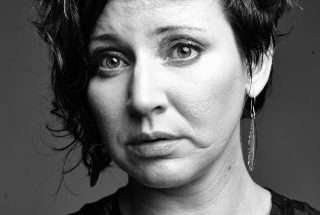|
Back
Devil in the Details New York
Weill Recital Hall
04/19/2018 -
Wolfgang Amadeus Mozart: Divertimento in E-flat Major, K. 563
Arnold Schoenberg: Pierrot lunaire, opus 21
Mellissa Hughes (Soprano)
Ensemble Connect: Rosie Gallagher (Flute), Bixby Kennedy (Clarinet), Mika Sasaki (Piano), Rebecca Anderson, Mari Lee (Violin), Maren Rothfritz (Viola), Madeline Fayette, Julia Yang (Cello)

M. Hughes
“…the rhythm should be observed as in ordinary singing; while a sung melody maintains its pitches, the spoken melody merely indicates the pitches and then moves up or down from them…”
René Leibowitz, Schoenberg and His School
Although Pierrot lunaire today seems like the commencement of something, it is in reality a finale to a style of musical thinking that desiccated when Schoenberg retreated to his study and developed over time the twelve-tone system of composition. It was as if the freedom of the ‘atonal’ frightened the composer, who felt the need to restrain and codify his musical inventiveness going forward. Ironically, his new style of composition was as constrained and organized as that of Bach, thus diluting the revolutionary aspect of his thinking.
Unfortunately Schoenberg’s dodecaphonic system made creativity all the more difficult. Alban Berg was the most successful at following the strict rules while also weaving tremendously emotional tapestries such as his Violin Concerto and the unfinished opera Lulu. The inventor of the new orthodoxy ended caught in the weeds of number systems and triskaidekaphobia, leaving only a small number of pantonal (Schoenberg hated the term ‘atonal’) works with deep emotional content. A Survivor from Warsaw and the Golden Calf scene from his opera Moses und Aron blend strict neoconservative compositional techniques with heart on sleeve emotions, but these small examples are the exceptions rather than the new rules.
That earlier pre-system otherness was on display as the brave musicians of Ensemble Connect launched this extremely difficult piece of musical pyrotechnics onto the rather intimate crowd at Carnegie Hall’s attic wonderland – its accoutrements the most ravishing in the city. If this were an Olympic event, the degree of difficulty alone would have earned them a perfect 10 from the judges.
The Mozart on the program was meant as a curtain raiser in a hall too small to accommodate a curtain. This was jollity personified – Wolfie would have made a fine career for himself in the present day by composing beer commercials. All was diaphanous and frivolous and the small crowd loved it.
Of course we had all come to hear Pierrot. This was rather problematical as those of us who did not go into the lobby for intermission saw a very tall ghoulish figure with a shaved head just standing on the stage while the furniture was rearranged. Once everyone in the audience was back in their seats, a small woman came out and began to talk inaudibly to the audience. Ignoring several cries of “we can’t hear you” and other less polite exclamations, the woman continued on for quite some time. I found that I could not answer the question “Which is Worse – a lecture where one cannot hear the gist of the argument or one where one can”. Eventually the woman and the sinister figure sat down and had a conversation – rather a one-sided one as only the monster was audible. By then the audience had stopped shouting and, of course, also stopped listening. The horror movie figure turned out to be Schoenberg, a particularly sophomoric devise.
Once the musicians came out to perform it was obvious that there was yet another problem. Ms. Hughes was really not able to be heard over the instruments. There were no visible microphones on the stage and so the sprechstimme effect was blurred and the auditory balance quickly destroyed. I admit to leaving before the end, but noticed that in the bar on the television one could hear all of the parts both vocal and instrumental. There therefore had to be some ambient microphones somewhere on or around that stage. Too bad that whoever was responsible for the coordination of this event was asleep at the wheel.
Other singers of note who have performed Schoenberg’s challenging masterpiece include Christine Schäfer, Helga Pilarcyzk, Bethany Beardslee, Yvonne Minton, Anja Silja... and Bjőrk.
Fred Kirshnit
|